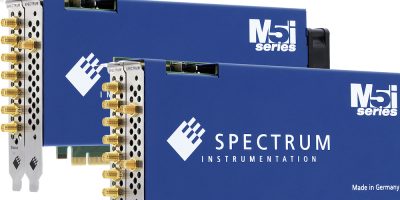PCIe digitiser cards accelerate sampling rates
Two ADC cards have been added to Spectrum Instrumentation’s M51 PCIe digitiser range. The two new models offer the company’s highest bandwidth capability to date, up to 4.7GHz for -3dB attenuation or 5GHz for -5dB attenuation.
The M5i.3360-x16 and M5i.3367-x16 provide one and two channels respectively. Each card is capable of sampling at rates up to 10Gsamples per second with 12-bit vertical resolution for acquisition and analysis of signals. The high bandwidth, combined with fast sampling, allows signals to be analysed for frequency content anywhere from DC to the Nyquist limit (half the sample rate, or up to 5GHz), making them suitable for working with extremely fast signals in laser systems, semiconductor testing, spectroscopy, reflectometry as well as a variety of RF applications.
Oliver Rovini, chief technical officer, at Spectrum Instrumentation, said: “More bandwidth means less signal attenuation at higher frequencies. It also makes it possible to detect and measure faster pulses and signal edge speeds. As such, bandwidth is critical for any engineer or scientist that wants to measure and characterise high frequency electronic signals”.
The company’s digitiser line is based on 12-bit ADC technology and now consists of seven models with sampling rates from 3.2 to 10Gsamples per second and bandwidths from 1.0 to 4.7GHz.
To handle a diversity of input signals, the raw acquisition performance is complemented by flexible front-end circuitry with programmable full-scale ranges, from ±200mV to ±2.5V and input offset. Acquisitions can be stored in a 4Gbyte (2Gsamples) of on-board memory (16Gbyte or 8Gsamples is optional) and transferred over the PCIe bus at fast speeds. All cards of the M5i series use 16-lane, Gen 3, PCIe technology, which allows the acquired data to be streamed at 12.8Gbytes per second. The on-board memory can be used as a ring-buffer, working like a conventional oscilloscope, or as a FIFO-buffer for continuous data streaming. The data can also be sent to PC memory for storage or directly to CPUs and CUDA-based GPUs for customised signal processing and analysis.
Acquisitions can be made in both single-shot or multiple-waveform recording modes. Multiple-waveform recording allows the capture of numerous events, even at very high trigger rates. Conventional edge triggering, includes trigger time stamping and is enhanced by trigger modes, e.g. window, re-arm, delay and software, that help with the capture of the most elusive events. There is also the ability to use the cards inputs (channel, trigger and digital lines) to set up specific trigger conditions based on Boolean logic.
The cards are suitable for automated testing systems and are supplied with all the tools necessary to use them in a PC running either a Windows or Linux operating system. A software development kit (SDK) enables the cards to be programmed with popular languages, such as C, C++, C#, Delphi, VB.NET, J#, Python, Julia, Java, LabVIEW, and MATLAB. The SDK contains all the required driver libraries as well as numerous programming examples. For users who do not write code, Spectrum Instrumentation also offers SBench 6 Professional, a measurement GUI for full card control, with display, analysis, storage, and documentation capabilities. It also includes processing techniques such as FFTs, for frequency domain analysis, and data interpolation for improved timing measurements.
The M5i.3360-x16 and M5i.3367-x16 data acquisition cards carry a five-year product warranty, with free software and firmware updates, as well as customer support directly from the engineering team for the life of the product. All the digitiser cards are available now with delivery being four to six weeks after the receipt of an order.




